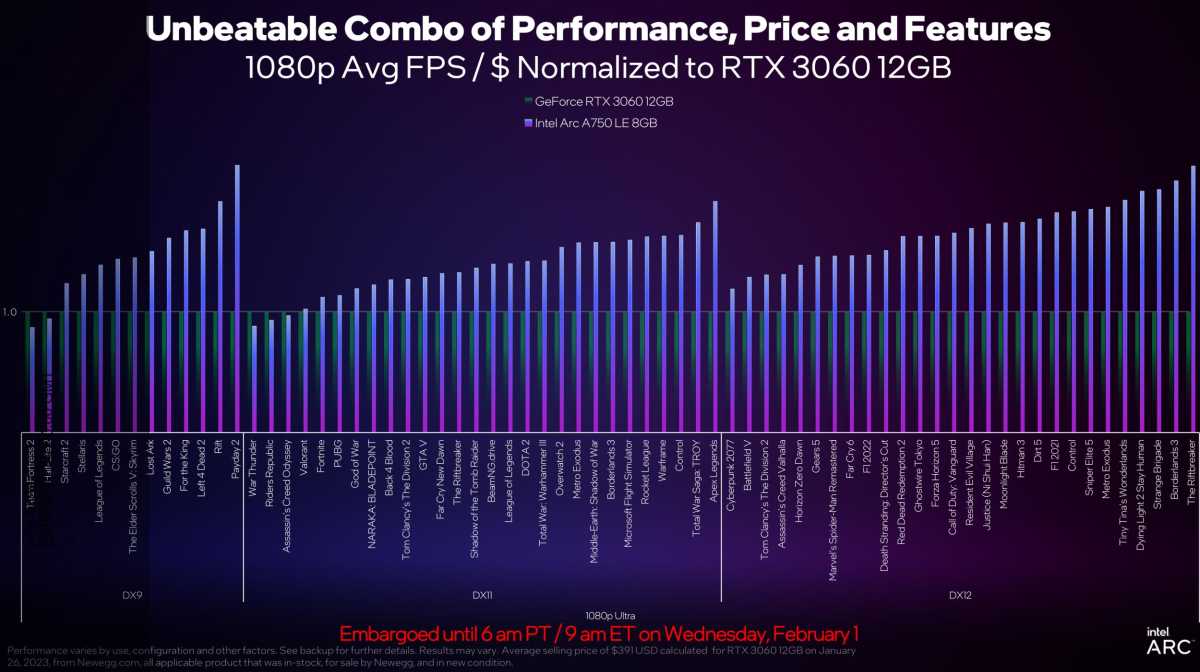It’s a hard time to be a PC gamer on a budget. If you’ve only got $250 to spend on a new graphics card, your only real option has been AMD’s Radeon RX 6600, as prices for GeForce GPUs remain painfully high. No more. Intel is dropping the price of its Arc A750 Limited Edition graphics card to $249 today, a $40 reduction, and making noise about the significant performance and stability increases its debut GPUs have enjoyed since their October launch.
If you’re a regular PCWorld reader, that shouldn’t come as a surprise. Intel’s first consumer GPUs launched with bugs and rough edges galore, so we’ve been periodically reevaluating Arc’s performance in a monthly video series. Intel’s drivers are already much more stable than before, and the company recently released new drivers that dramatically improve the raw speed and overall smoothness in DirectX 9 games like Counter-Strike: Global Offensive and League of Legends.
“Across low- and high-end graphics settings, we’re seeing a 2x increase in frame rates,” we said after testing a handful of titles. Intel says DX9 games now run an average of 43 percent faster than on Arc’s launch driver, and 60 percent smoother. Yes, please.
The focus hasn’t all been on older games though. Coinciding with today’s Arc A750 price drop, Intel is launching another new driver with improvements across a variety of DirectX 11 and 12 games, including a massive 57 percent uplift in Warframe (DX11) performance. That’s vital; our Arc A770 and A750 review showed Intel’s GPU often besting Nvidia’s popular RTX 3060 in ray tracing and DX12 games, but optimizing DX11 titles requires a lot more work from the GPU drivers, and Arc can suffer hard there. Intel hasn’t been shy about saying this will require long-term focus from the team, and they’re clearly putting that work in.
Intel has pushed out eight “Game On” drivers since launch, with optimizations for 21 games, and 35 titles have pledged support for XeSS—Intel’s DLSS rival.
Speaking of Nvidia and the RTX 3060, it’s still selling for wildly inflated pricing on the streets, and Intel is seizing onto that fact to drive home the value of the newly $249 Arc A750, as per the complex, but striking chart below. It shows the average 1080p frames per second per dollar for the A750, normalized to the RTX 3060’s average FPS per dollar as the baseline in each game. So in games where the blue bars are higher than the green bar, the Arc A750 is a better value per dollar (and vice-versa).

Intel
This is not a chart showing overall performance, just value, and the RTX 3060’s roughly $380 average street price hurts it deeply here. When you’re looking at raw frame rates alone, without considering the value prospect, our testing showed the Arc A750 sometimes winning big against Nvidia, and sometimes losing big, depending on the DirectX version and game engine used. As with many things Arc, it’s complicated.
Intel Arc A750 vs. AMD Radeon RX 6600
Ignore the highly priced RTX 3060 though. For gamers, the bottom line here is that the Arc A750 is now $249, and Intel’s drivers and stability have been rapidly improving. After years of wandering the GPU wasteland, we now have two graphics cards available new for $250 or less. So should you buy the Intel Arc A750 or AMD’s rival Radeon RX 6600?
We’d still recommend the Radeon GPU for most people. While many new triple-A games run on DirectX 12, most PC games still run DX11, and AMD’s DX11 support just works at full speed. The Radeon RX 6600 also runs well in any computer, while the Arc A750 needs a fairly modern system with PCIe Resizable Bar active or its frame rates plummet.
That said, now that Intel upped DX9 performance so heavily and put intense effort into driver stability, the Arc A750 seems fairly compelling, especially for under $250. Its DX12 and ray tracing performance blows past even the much more expensive RTX 3060 in many games, and now, its handling of games running older DirectX versions is much better than before. Even if the Arc A750 can’t match the Radeon RX 6600 in raw DX11 performance, it still delivers a wholly playable experience there, and all the specific driver bugs mentioned in my Intel Arc launch review have been fixed.
If you tend to play new, big budget blockbuster games or want to poke around with ray tracing without breaking the bank, the newly $249 Intel Arc A750 may very well be worth considering. Mainstream gamers have actual options now! Yay competition.
Expert's Rating
Pros
- Excellent performance in DX12/Vulkan games
- Best-in-class raw ray-tracing performance
- Intel’s Limited Edition cooler design is cool, quiet, and attractive
- AV1 encoding
- Inexpensive
Cons
- Requires PCIe Resizable BAR for good performance
- Lagging performance in DX11 games
- XeSS works well, but only in a handful of games
- Some rough edges in software
Our Verdict
The Arc A750 Limited Edition is a graphics card that offers great value and exceptional performance in ray tracing and DX12 games, but there are many caveats to consider before buying it.



